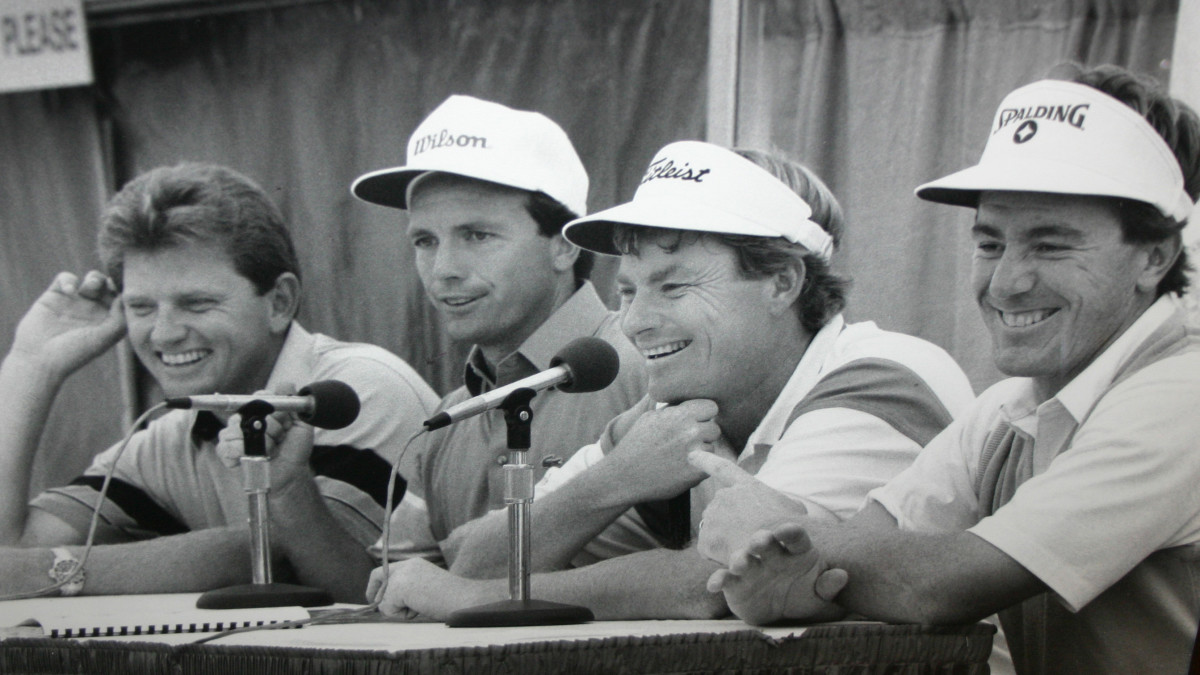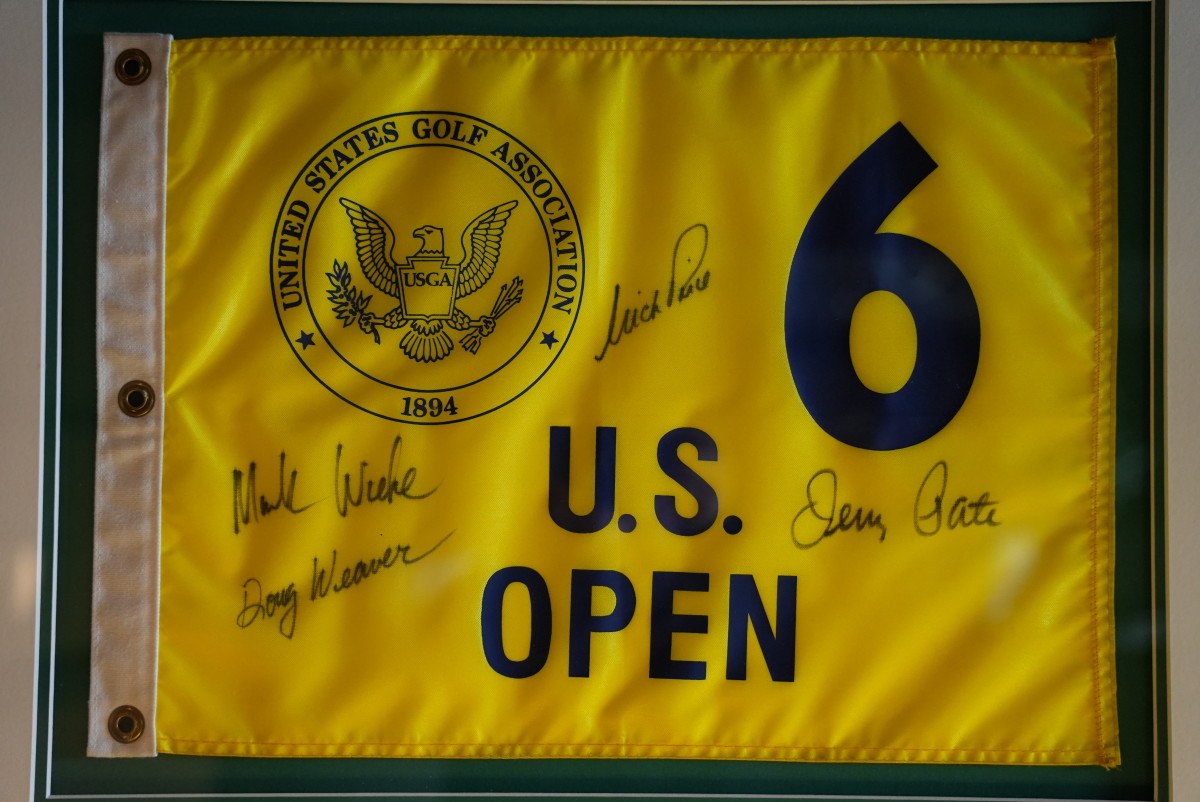'We Have Another Hole In One': The Day the Legendary Four Aces Landed at Oak Hill

ROCHESTER, N.Y. – Thirty-four years later, it still seems impossible.
One of golf’s greatest statistical anomalies occurred during the second round of 1989 U.S. Open at Oak Hill Country Club, the site of this week’s PGA Championship. All those who know the legend guarantee one thing: that series of events will never, ever happen again.
Here’s why.
On Friday, June 26, during the second round of the 89th U.S. Open, the golf world was introduced to the “Four Aces.” This was long before Dustin Johnson or a Saudi-backed golf league created a team by that same name.
On that day, four holes in one were recorded at Oak Hill during the same round, on the same 167-yard par-3 6th hole, with the same club, 7-iron, within a span of less than two hours.
At 8:15 a.m. on that charmed morning, Doug Weaver, playing in the first group of the day, hits his 7-iron 15 feet right of the pin. At 9:25 a.m, Mark Wiebe sends his tee shot on No. 6 about eight feet left of the flag. It’s Jerry Pate’s turn at 9:50 a.m., and his shot lands seven feet past the pin location. At 10:05 a.m., Nick Price, playing in the group directly behind Pate, hits a shot shape that closely resembles Weaver’s, landing eight feet right of the flagstick.
All four shots end up at the bottom of the cup.
In the 88 previous U.S. Opens, there had only been 17 holes-in-one, making four in one day even more unfathomable. According to Oak Hill’s historian, Fred Beltz, a mathematician calculated the probability of the aces at 410 quadrillion to one. Golf Digest put the chances at only 332,000 to one. The National Hole in One Association estimated that four holes in one in the same round, on the same hole, will statistically not happen for another 190 years.
“I didn’t hit one of those shots where you stand over it and you say, ‘go in the hole,’” says Price, 34 years later. “It was eight or nine feet right, but it was such a tiny green. My ball pitched to the right of the flag, and then just turned into the hole.”

With a cup-shaped green, the 6th hole was defended by a bunker on the right and Allen’s Creek—which runs through much of Oak Hill’s property—on the left. The day the Four Aces were recorded, Bernhard Langer pulled his tee shot into the hazard and made a double.
Conditions were soft from a steady rainfall the previous day, and the pin placement was in the lower lobe of the putting surface, as decided by the USGA’s Director of Rules and Competition, P.J. Boatright and the Championship Agronomist, Tim Moraghan. That particular hole location wasn’t in any sort of funnel per se, but drama was surely anticipated.
“I like to say that if they intended to create some Friday excitement, they were very successful,” says Beltz, Oak Hill’s club historian of 20 years. “They put the hole location more or less at the base of the lobe on the green, and as Tim told me, the two of them were walking away, and one said to the other, ‘that could be a hole in one spot,’ to which the other replied, ‘maybe more than one.”
Boatright and Moraghan were spot-on.
Four shots like those will never again be hit on the property, not because today’s professional golfers can’t replicate such a series of swings, but because the par-3 No. 6 at Oak Hill’s East Course no longer exists.
In 1976, George and Tom Fazio were tasked with modernizing Donald Ross’s original East Course design to accommodate major championship spectators and increase the course difficulty. They added the par-3 6th, but the hole never seemed to align with Ross’s intentions for the property. In 2019, the club decided to do something about that, hiring Andrew Green to restore the piece of land to its original layout, meaning that the legendary Four Aces hole would be scrapped.
“This is the first major championship that we’ve hosted without the sixth hole since the Four Aces,” says David Fries, an Oak Hill member and former club president. “That possibility is no longer there. That ground is going to forever have those stories, but it can never be replicated.”
Donald Ross had a vision for a short par-3 on the front nine, and as part of Green’s 2019 renovations, a version of it was restored as the new No. 5. The hole is called “Little Poison.”
“The holes that Fazio did were always a bone of contention for members of the club, because they were inconsistent with Ross’s plan,” Steve DePerrior, a longtime member of Oak Hill, says.

If transported to 2023, the Four Aces would have been the viral hit of the day. The shots would have been retweeted, reposted on Instagram and recapped on Golf Channel’s Live From for days to come. ESPN’s "SportsCenter Top 10" editing team could stop after No. 5 and simply “insert the Four Aces here.”
But back to ‘89, this is where the story’s mystique grows: Not a single one of the aces was recorded on the U.S. Open TV broadcast.
“It was first thing in the morning, and that hole didn’t even have TV coverage,” Beltz says.
According to Price, who made the final ace of the historic day, it’s probably a good thing the hole didn’t have constant camera action for the sake of one man in particular—the marshal on the 6th tee box.
“As I walked on to the tee, the marshal came walking up to my caddie and I and the other two players in the group and he said, ‘You’ve got to know how to do it, you’ve got to know how to do it,’ and started to talk. We just said, ‘no, you can’t say anything, because you’re giving us advice. Don’t say anything, please.
“But he was so excited and agitated. I get over the shot and I can’t remember whether I had the honor of first, second or third. And he starts whispering to my caddie, what I should do. Of course, I couldn’t hear a thing that was going on. I was completely oblivious to what he was giving my caddie, because I was over the ball.
“Anyway, as I hit this ball, the ball is in the air and this guy starts shouting, ‘that’s it! That’s where it goes in from!’ The ball bounced on the green and rolled to the left—the pin was in this bowl—and it went in the hole. I was stunned. I never thought I was going to be the fourth. So it was really kind of strange. I mean, people were going crazy.”
Without hundreds of iPhone camera lenses watching, that marshal was saved from being blasted on social media. Suspected rules infractions—take Brooks Koepka’s and Gary Woodland’s caddies at the recent Masters, for example—tend to get the people going, whether he meant to cause problems or not.
Photographs, newspaper articles and post-round interviews from the players themselves prove the Four Aces actually happened. A few eyewitnesses can also recount the wild Rochester morning with color and joy.
Steve DePerrior was 31 years old when he joined Oak Hill just months before the ‘89 Open. DePerrior volunteered as a USGA “roving scorer” for holes 4, 5 and 6, and a walkie-talkie was his only lifeline back to the clubhouse to verify that scores for that stretch were being recorded.
DePerrior happened to choose the 6th tee box as his post for the morning, and he witnessed the first ace by Weaver. “He hit 15 feet past the hole and sucked it into the jar,” DePerrior reported with his walkie-talkie. That exact quote was printed in the newspapers the next morning.
Without a camera in sight or anything even resembling ShotLink or Trackman technology, DePerrior’s word was gold. That is, until the second ace came along. Wiebe’s ace happened an hour later, and DePerrior again took to his communication device: “We have a hole in one on No. 6.”
“We already got it,” the scorer’s tent replied. DePerrior clarified: “No, we have another hole in one on No. 6.”
Finally, when Pate’s ace dropped, DePerrior made sure to use appropriate adjectives, to once again call in an ace: “We have another hole in one.”
DePerrior was met with an initial period of dead silence, until a voice came through the walkie talkie with a rather strange message: “Uh, Steve, we’re going to send someone out to relieve you.”
“They had thought that at 9:50 in the morning, I had been drinking or had lost my mind, and therefore, they were going to relieve me of my responsibilities. I said, ‘No.’ This is a third hole in one,” DePerrior says.
DePerrior was checking in on the 4th and 5th holes, so he didn’t see the fourth and final ace by Price, but he didn’t need to. He’ll remember that particular ace differently—by a deafening roar.
Price himself, however, doesn’t even want to remember his own ace. And in fact, the other players who made holes-in-ones that day probably don’t have fond memories of the championship in its entirety, either.
The best finish of the Four Aces was Wiebe, who posted a T33 at 9 over par for the tournament. Weaver tied for 69th at 20 over. Price and Pate missed the cut—badly—which meant they had to sit through the ensuing media mania after Friday’s round and then get packing.
“When I look back now, it’s a wonderful thing to have been a part of. But only two of the guys were really happy, looking forward to the next day. Jerry Pate and I missed the cut. We were fine, but it wasn’t the happiest moment of our lives,” Price said.
Price has 17 holes-in-one now, but he doesn’t take them for granted—he simply would have preferred to make the weekend at the major championship. An amateur would have taken a 90 that day if it meant a “1” on the card, let alone a chance to be forever cemented in this strange piece of Oak Hill history. Not Price.
“I was really teed off that I’d missed the cut. I would have rather made a 2 or a 3 on that hole and made the cut. But it’s part of history.
“You wouldn’t be talking to me now if I had made a 2.”
Oak Hill built a new halfway house last season, and it stands just yards away from the original site of that lost par-3. A framed flag hangs on the inside—the same flag that flew over No. 6 back in 1989, signed by all four golfers.
Moraghan—the USGA Championships Agronomist who helped choose the hole location—had the original flag hanging in his office for nearly 30 years until one day, he decided it belonged back in Rochester.
“I don’t know really what prompted him to do that,” says Beltz. “If I had something like that I’d probably hang on to it for a while before I gave it away.”
Today, the halfway house is known by members as “Aces Cafe.”

